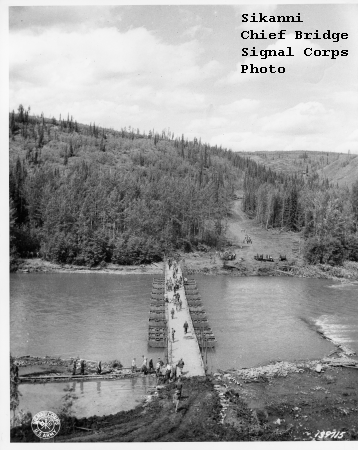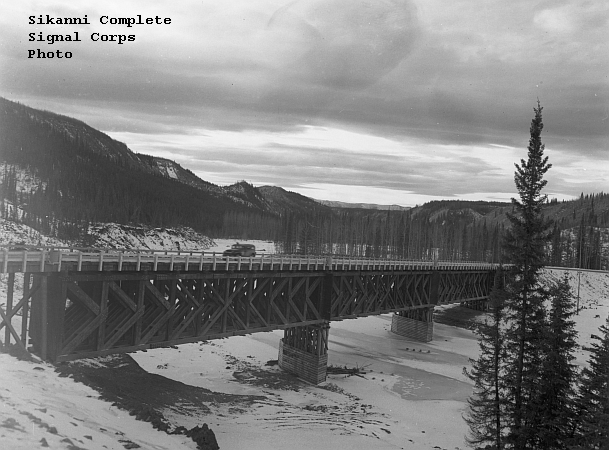
Five days, that’s what the Southern Sector commander gave the 95th to bridge the Sikanni Chief. The soldiers got to work.
Link to last episode in the series “Morale Leads the 95th to Sikanni Chief”
In the surrounding woods, Sgt. Harvey and Pvt. Hickens selected trees—monsters for trestles that would stand up out of the water and support the bridge; long, straight ones for bridging timbers that would run horizontally from trestle to trestle; and an endless number that could be turned into the decking that would span the bridging timbers and provide the roadbed. As fast as Harvey and Hickens could select them, their fellows swarmed to cut them down, lop off limbs and hew them into timbers and planks. And as fast as bridge members emerged from the raw timber, others swarmed to drag them down to the riverbank. Pvt. Dulin remembered his platoon “that trimmed the trees, sawed them and made posts of the bridge. It was a big thing to do.”
The point platoons worked in the water. Anchored to the shore with ropes, they waded, chest deep, icy water surging around them. They built cribs up from the bottom; floated the massive trestles to them and stood them upright; filled the cribs with rocks to stabilize the trestles. The soldiers rotated into and out of the water. Numb and stiff, one group would struggle ashore to warm themselves at roaring fires, while another took their place in the torrent.

When they had trestles in place, the men in the frigid water hoisted bridging timbers to span from trestle to trestle. Then, finally beginning to emerge from the water, they spanned the bridging timbers with decking.
The whole area around the emerging bridge hummed with activity. The men in the woods made music; sang spirituals; kept time with their ringing axes. And the work didn’t stop when the sun went down. At night a line of trucks cast their headlight beams into the darkness to illuminate the site.
Pfc’s Wilmore and Waldrum were bridge carpenters; worked thirty hours at a stretch. Sgt. Price supervised dynamite settings and blasted over twenty cuts into the mountain. Cpl. George Hack built bridge abutments.
And, if the men worked day and night, so did the cooks. They provided warm meals three times a day and midnight snacks of hot coffee and biscuits.
Not five days; not even four days; in just three days the frantic activity ground to a halt. The 95th had bridged the Sikanni Chief.

My Dad, Capt. Stanley Covington Powers led a all black squad with the 95th Engineers on the ALCAN highway. Later, they shipped over to England to set up for Normandy. He wound up in Belgium in the Battle of the Bulge.